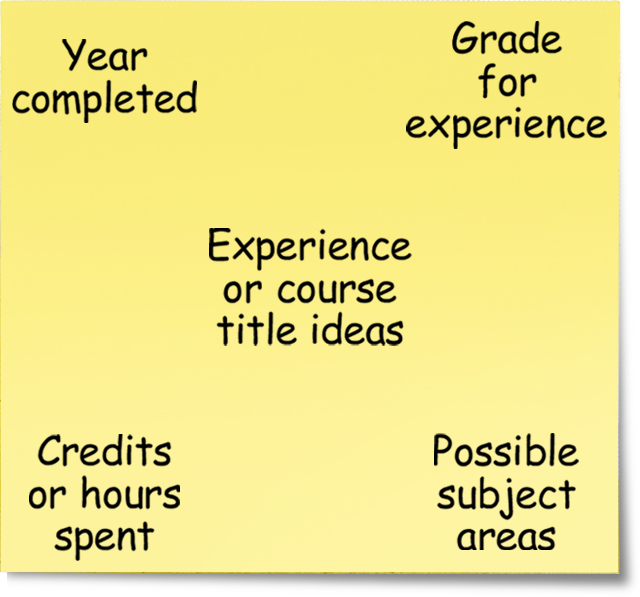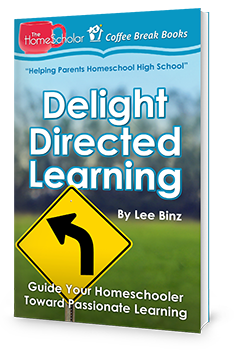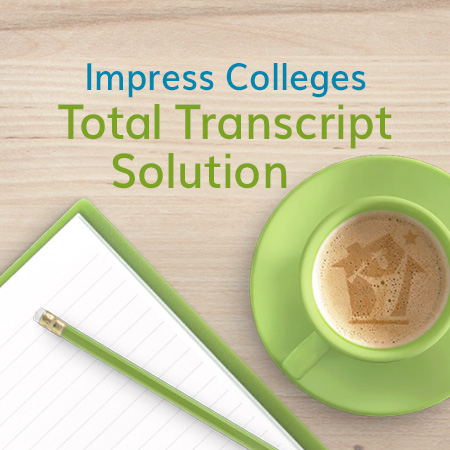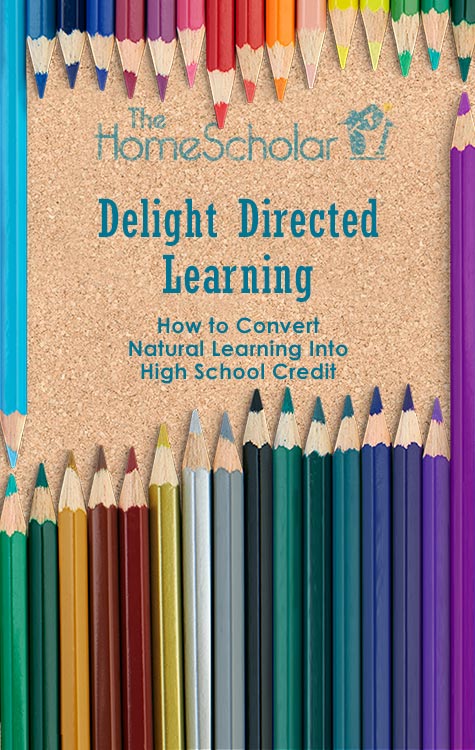Delight Direct Learning Makes Homeschooling Better
Delight directed learning makes homeschooling better for everyone involved. For parents, it reduces burnout, improves children’s cooperation, and develops self-motivated learners. For children, it increases the love of learning and makes learning more relevant and meaningful. Delight directed learning will shape and mold your child’s career goals, lead to great experiences that can be put on the transcript, and helps create a fabulous resume. It can improve your child’s chances of earning college admission, scholarships, and job opportunities - all while still in high school.
Delight directed learning is sometimes called specialization or child-led learning and colleges sometimes call it passion. It can be self-study, self-motivated, self-directed learning. These self-directed interests can develop into passions that lead to careers. The solution to dull drudgery and hated homeschooling is allowing it to happen naturally. Be warned, though! Parents often call it "frustrating, boring and annoying" if they don't have the same interests as their child.
Learn how to put fabulous fun on your homeschool transcript and convert natural learning into high school credit with this free Ebook: How to Convert Delight Directed Learning Into High School Credit
Be students of your student. Watch what they do for fun.
Independent learning can be included within core subjects when the child fancies academic subjects such as history or English. For other families, the five major subjects (English, math, history, science and foreign language) are intentionally taught quickly within the first few hours of the day. The remaining school hours include high school credits collected from delight directed learning.

Avoid Excessive Technology
To successfully include delight directed learning in the homeschool, parents need to avoid one huge impediment to learning. That elephant in the room, the hurdle you need to overcome, is staring you in the face right now. Technology can thwart or completely shut down passionate learning.
Delight directed learning requires time. Make sure to build margin into your homeschool.
The overuse of technology limits free time, steals margin, and eliminates boredom. Without free time (and frankly, without boredom) children never learn to entertain themselves with interesting pastimes. To develop passionate leaners, you need to limit TV, computer, tablet, and smart phone use. A reasonable amount of technology is about two hours per day, including social media and gaming. This allows the teen enough time to goof off, but isn't so much that it impedes development of interests. If you feel as if you need help with the harsh reality of technology in your home and how to set technology boundaries for healthy and happy children and teens, check out my book, TechnoLogic: How to Set Logical Technology Boundaries and Stop the Zombie Apocalypse.
Let Delight Directed Learning Come Naturally

The Sticky Note Strategy
What if your child soaks up knowledge like a sponge, without being directed in any way? Some students learn best through living instead of studying textbooks. Can you still create a serious-looking high school transcript? Yes! However, nobody will ever know the fun or magical things your child has done unless you tell them.
When speaking to colleges, you need to use words and numbers that colleges understand. Applying to college isn't like talking to your friend or a seasoned homeschool parent who understands the daily grind of homeschooling high school. Even so, colleges do understand grades, high school credits, and educational language. You need to keep those records.
Once I figured out how to keep track of my kids’ delight directed learning, I realized that my system would work for all delight directed learners (not only “book learners”). I also realized that it could help parents who are kinesthetic learners themselves. My strategy is simple, fun, and only requires one small purchase. Sticky notes. Yup. Those small square notes save the day again! You can determine what to do with each experience using a simple sticky note.
For each activity your student is involved in, there are five pieces of information you need to remember. Write these five things on the sticky note and save it with your homeschool records. At the end of each year, group those sticky notes together, and combine them to create high school courses.
I recognize it’s hard to determine where each experience will fall on a transcript, so keep each sticky note simple. Here is what I suggest. On each note, indicate each of the following details.

4. Note Credits Earned or Hours Spent

The Testing Strategy
Another way to quantify delight directed learning is to give subject tests. This doesn’t work for every subject or every child, but it’s an option to consider. Instead of testing your child as they are learning, allow them to learn a subject naturally. When they are done, you can give them a sample test from a major test provider. If they pass the sample test at home or at the testing center, you know how much they have learned and have a grade to put on their transcript. There are three tests available that will help with this strategy: Advanced Placement® (AP®) exams, and CLEP® tests from the College Level Exam Program.
Parents don’t always know what their children are learning. There is so much life that goes on without parental involvement – and so many books! It’s amazing what children learn when you aren’t looking!
Using CLEP® exams, I found out how true this could be! I told my students to look over the exams “just to see what they were like.” One son was able to pass an exam in “Business Law,” even though I had never seen a law book in my home. He passed the “Principles of Marketing” test, even though I had never seen a marketing book in my home. He passed both “Microeconomics” and “Macroeconomics,” even though I still don’t know exactly what those two words mean. By testing them, I was able to include some courses on the transcript that were a surprise even to me!
When using tests to document delight directed learning, be sure to avoid failure. Purchase a book with sample tests in it and give the exam at home first. Only take your student to an official test if you are reasonably sure they can pass. Your goal is to find out what they have learned, not demonstrate what they have not learned. For more information on AP® exams and CLEP® tests, download my free eBook, College Credit in High School: Critical Tests that Increase Admission Chances and Decrease College Costs.

Find Balance
To homeschool high school effectively, include as much delight directed learning as possible. A fun learning environment does not make school easy, it makes it interesting and applicable. When school is interesting, children learn more and love learning more.
Parents need to find a balance, however. College preparation means parents must cover the core classes and at the same time allow for delight directed learning. When you can, cover the core and capture delight with independent learning.
When planning your week, first be sure to cover the core classes of reading, writing, math, science, and social studies. Each family has classes they consider non-negotiable core classes. Within these core classes, try to teach in an interesting way. It's possible to teach many core subjects with delight directed classes, but make sure you cover the core one way or another.
Once the core is covered, capture your child’s delights. Translate them into courses on your child’s transcript. You don't have to plan, direct, or evaluate learning through tests or quizzes. Simply capture your child’s learning.
This article is an excerpt taken from Chapter 10 of my book, “Setting the Records Straight: How to Craft Homeschool Transcripts and Course Descriptions for College Admission and Scholarships” available on Amazon.
Recommended Resources

Learn to identify and avoid the big blunders repeated by countless homeschool parents!
The First Mistake may cripple your plans if your child ever changes their mind (and what teenager doesn't!) The Second Mistake may leave your child unprepared for college! The Third Mistake may result in the loss of thousands of dollars in financial aid! The Fourth Mistake may cause your child to be lost in the crowd during college admission. The Fifth Mistake may render your kid unable to gain admission to the college of their dreams!

Parents who know how to homeschool high school understand that a solid education involves more than just the standard high school courses. It is true that mastering science, math, and literature is part of the joy of homeschooling high school (and vitally important if college lies ahead), but equally important are subjects the self directed teen is passionate about, subjects they will study for hours on end, just for the fun of learning. Delight directed learning is the true “secret sauce” of a great homeschool education.

The amazing transcript secrets known by top colleges officials that will unlock university admission decisions and top scholarship awards.
The Total Transcript Solution is the end of your homeschool transcript worries! It includes simple DIY instructions, classes to get you started, and easy-to-use templates. This is a really good value, because you can use it for all of the students in your family. You will have access to your resources forever.

 Login
Login



